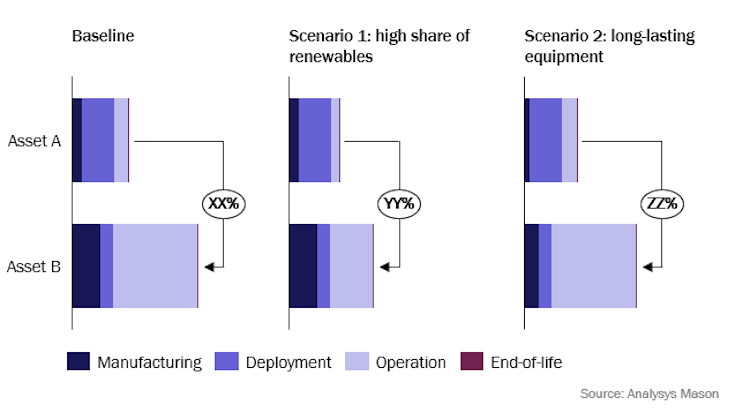Sustainable decision-making for digital infrastructure is impossible without full lifecycle assessments
29 November 2024 | Research
Hugues-Antoine Lacour | Sabre Konidaris
Article | PDF (4 pages) | Sustainable Networks
Owners of digital infrastructure assets face escalating pressure to accurately quantify and reduce their carbon footprint. Estimating carbon emissions associated with the expected lifecycle of future deployments is central to understanding and maximising the sustainability of future network designs. Conducting carbon lifecycle assessments is a complex exercise given the scale of digital infrastructure assets and the varied characteristics of their components. A robust, tailored approach is vital if owners of digital assets are to have a clear view of the economic and carbon costs of their infrastructure.
This article outlines best practices for conducting carbon lifecycle assessments on digital infrastructure assets, drawing on key insights from our recent projects.
Carbon emissions modelling is becoming increasingly important for digital infrastructure owners
As the Earth passes the pivotal threshold of 1.5ºC of heating above pre-industrial levels,1 pressure is building across all sectors to ensure the sustainability of economic activity. Regulatory requirements are becoming broader and more stringent; consumers and investors are setting more demanding expectations. Owners of digital infrastructure assets, such as fibre, mobile and satellite networks or data centres, need continued effort to ensure they are accurately quantifying and reporting the carbon emissions associated with their assets in order not to fall foul of emerging regulation, sustainable financing criteria and increasingly environmentally-conscious customers.
- From a regulatory perspective, global initiatives such as the European Green Deal, the Science-Based Targets initiative (SBTi requirements) and national commitments specify ambitious targets for carbon reduction and sustainability practices across industries. For instance, the UK government’s new COP29 commitment to cut emissions by 81% by 2035 will require digital infrastructure owners to assess their current emissions but also to ensure that any future emissions associated with planned deployments are aligned with this target.
- From an investor perspective, the environmental footprint of proposed new projects should be factored into the cost-of-ownership model both to understand overall viability, and especially to be compliant with sustainable financing criteria. Failure to do so can lead to significant financial risks, as investors increasingly prioritise projects with transparent and reduced carbon impacts. Digital infrastructure assets are long-lived (often exceeding 15 years) and subject to evolving standards and compliance requirements.
Against this background, accurate modelling and projection of the carbon emissions associated with future infrastructure deployments is becoming critical. Quantification of carbon emissions is central to a clear understanding of the sustainability of future infrastructure designs and identification of viable pathways for carbon reduction and management. The entire expected lifecycle of the digital infrastructure asset must be assessed if owners (as well as investors and regulators) are to reach a comprehensive understanding of the long-term environmental impacts from the manufacturing and installation of equipment, to operations and eventual decommissioning and disposal.
Conducting a carbon lifecycle assessment of digital infrastructure assets is complex
Digital infrastructure assets are large, intricate systems composed of an array of individual components, each of which is deployed, upgraded and decommissioned over time, and must be accurately sized and accounted for within the scope of carbon emissions modelling. Not only will equipment be sourced from a changing mix of manufacturers and locations, but the deployment of a given piece of infrastructure in one location may have a different carbon footprint in another location (owing to factors such as local grid energy sources).
Figure 1 provides a high-level overview of the key activities occurring at each stage of the lifecycle of a fibre access network as an example, from the manufacturing of the key components of the network, to their deployment, operation, decommissioning and disposal. Broadly similar lifecycle stages and activities are applicable to other networks, such as cable (DOCSIS), mobile, fixed-wireless access (FWA), satellite or other types of digital infrastructure assets (including data centres).
Figure 1: Fibre (FTTP) network equipment lifecycle

Without robust, tailored methodologies, there is a risk of either oversimplifying or overlooking critical emissions hotspots. This not only makes it difficult to identify areas for improvement (and cost minimisation opportunities) but also opens the operator up to accusations of inaccurate reporting.
A detailed and robust methodology is essential for lifecycle assessments to be credible
Best-in-class modelling needs to be carefully scoped, and should be built on assumptions that appropriately reflect the specific market context. Lifecycle assessments should be approached in four important stages:
- Defining the scope of the lifecycle assessment: set clear system boundaries, such as determining which parts of each asset to include, defining the lifecycle stages to be considered (if relevant), selecting the most appropriate ‘functional unit’ to facilitate a meaningful comparison, and establishing the observation period providing the time horizon for emissions calculations. At this stage, other impact categories beyond carbon, such as water use, ozone depletion, or toxicity (among others), may also be identified for inclusion. Any cut-off criteria, such as deciding to exclude emissions from processes that contribute minimally to overall impact, are also defined at this stage.
- Detailed asset modelling: map out asset components (for example, customer equipment, routers, switches, street cabinets, antennas) and estimate equipment needs over time. Geo-analysis and population mapping techniques, which involve assigning population densities to geographical locations, can help calculate the precise amount of infrastructure required, allowing for highly accurate infrastructure planning.
- Estimate unitary emissions: quantify energy and materials required by lifecycle stage, and apply relevant carbon emissions factors, accounting for local energy mixes and transport modes.
- Model future emissions: project emissions based on projected equipment needs, accounting for deployment and replacement schedules, and carbon emissions factors. Model alternative scenarios (for example, shifts in energy mix, energy-efficient equipment, extended product lifespans through more durable designs) to identify the most effective carbon reduction pathways.
This holistic approach towards carbon emissions modelling ensures that sustainability considerations are integrated at every stage of the lifecycle, enabling digital asset owners to make forward-looking, data-driven decisions that not only meet regulatory demands but also position them as leaders in the transition to a low-carbon economy. Figure 2 provides an illustrative comparison of lifecycle carbon emissions for two distinct network technologies, and explores three alternative scenarios, namely: a baseline scenario reflecting a set of standard parameters in terms of equipment lifespans, country electricity mix, carbon emissions factors, etc.; a scenario reflecting the commitment pursued by some countries to achieve a higher share of renewable energy sources in their electricity mix by a certain point of time; a scenario considering the impact of greater equipment durability and longevity on carbon emissions.
Figure 2: Average annual carbon footprint (kg CO2 eq.) by digital infrastructure asset and scenario (illustrative)

Our recent carbon modelling and carbon allocation projects have demonstrated the value of best-in-class modelling. It gives asset owners the clarity to act decisively to gain a competitive advantage and to position themselves to thrive in an increasingly stringent regulatory environment.
Analysys Mason has 40 years of experience in the technology, media and telecoms (TMT) sector and is uniquely positioned to support telecoms operators, technology vendors and investors in conducting comprehensive carbon modelling across their digital infrastructure assets.
An exploration of Analysys Mason’s approach to carbon allocation can be found here. More examples of our wider work on sustainability in the TMT sector can be found on our sustainability page.
1 The 12-month period from February 2023 to January 2024 reached 1.52ºC of warming according to the EU’s Copernicus Climate Change Service.
2 Customer premises equipment (CPE).
Article (PDF)
DownloadAuthors

Hugues-Antoine Lacour
Principal
Sabre Konidaris
ConsultantRelated items
Framework report
Digital twins in telecoms: a framework for understanding the opportunity and ecosystem
Article
Using dark fibre to track geothermal energy offers network providers an opportunity to monetise their assets
Survey report
Fixed operator energy benchmarks 2024

